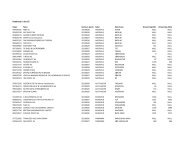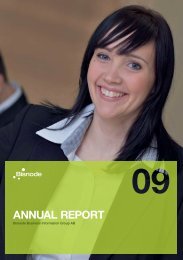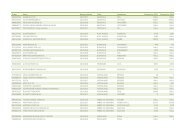Download PDF version - Bisnode
Download PDF version - Bisnode
Download PDF version - Bisnode
You also want an ePaper? Increase the reach of your titles
YUMPU automatically turns print PDFs into web optimized ePapers that Google loves.
38<br />
asset’s carrying amount exceeds its recoverable amount. The recoverable<br />
amount is the higher of an asset’s fair value less costs to sell and value in use. For<br />
the purposes of assessing impairment, assets are grouped at the lowest levels for<br />
which there are separately identifiable cash flows (cash generating units).<br />
2.10 Financial assets<br />
The Group classifies its financial assets in the following categories: at fair value<br />
through profit or loss, loans and receivables, and available-for-sale financial<br />
assets. The classification depends on the purpose for which the financial assets<br />
were acquired. Management determines the classification of its financial assets at<br />
initial recognition and reviews the classificiation at each reporting date.<br />
a) Financial assets at fair value through profit or loss<br />
Financial assets at fair value through profit or loss are financial assets held for<br />
trading. A financial asset is classified in this category if acquired principally for the<br />
purpose of selling in the short term. Derivatives are also categorised as held for<br />
trading unless they are designated as hedges. Assets in this category are classified<br />
as current assets if expected to be settled within 12 months; otherwise, they are<br />
classified as non-current. During the financial year, the Group had no assets<br />
belonging to this category.<br />
b) Loans and receivables<br />
Loans and receivables are non-derivative financial assets with fixed or determinable<br />
payments that are not quoted in an active market. They characteristically arise<br />
when the Group supplies money, goods or services directly to a customer without<br />
intending to trade with the claim that has arisen. They are included in current<br />
assets, except for maturities greater than 12 months after the balance sheet date.<br />
These are classified as non-current assets. This category includes trade and other<br />
receivables in the balance sheet.<br />
c) Available-for-sale financial assets<br />
Available-for-sale financial assets are non-derivatives that are either designated in<br />
this category or not classified in any of the other categories. They are included in<br />
non-current assets unless management intends to dispose of the investment<br />
within 12 months of the balance sheet date.<br />
Regular purchases and sales of financial assets are recognised on the tradedate<br />
– the date on which the Group commits to purchase or sell the asset. Investments<br />
are initially recognised at fair value plus transaction costs, for all financial<br />
assets not carried at fair value through profit or loss. Financial instruments are<br />
derecognised when the rights to receive cash flows from the investments have<br />
expired or have been transferred and the Group has transferred substantially all<br />
risks and rewards of ownership. Available-for-sale financial assets and financial<br />
assets at fair value through profit or loss are subsequently carried at fair value.<br />
Realised and unrealised gains or losses arising from changes in the fair value of<br />
the financial assets at fair value through profit or loss are presented in the income<br />
statement in the period in which they arise. Unrealised gains or losses arising from<br />
changes in the fair value of instruments classified as available-for-sale are recognised<br />
in other comprehensive income. When instruments classified as available-for-sale<br />
are sold or impaired, the accumulated fair value adjustments are included in the<br />
income statement as gains and losses from financial instruments.<br />
The fair values of quoted investments are based on current bid prices. If the<br />
market for a specific financial asset is not active (and for unlisted securities), the<br />
Group establishes fair value by using valuation techniques. These include the use<br />
of recent arm’s length transactions, reference to other instruments that are substantially<br />
the same, discounted cash flow statement and option pricing models<br />
that have been refined to reflect the issuer’s special conditions.<br />
The Group assesses at each balance sheet date whether there is objective<br />
evidence that a financial asset or a group of financial assets is impaired. If any<br />
such evidence exists for available-for-sale financial assets, the cumulative loss –<br />
measured as the difference between the historical cost and the current fair value,<br />
less any impairment loss on that financial asset previously recognised in profit or<br />
loss – is removed from equity and recognised in the income statement. Impairment<br />
losses recognised in the income statement on equity instruments are not reversed<br />
through the income statement.<br />
2.11 Derivative financial instruments<br />
Derivatives are initially recognised at fair value on the date a derivative contract is<br />
entered into and are subsequently remeasured at their fair value. The method of<br />
recognising the resulting gain or loss depends on whether the derivative is designated<br />
as a hedging instrument, and if so, the nature of the item being hedged.<br />
The Group designates certain derivatives as either: (1) hedges of the fair value of<br />
recognised liabilities (fair value hedge); (2) hedges of a particular risk associated<br />
with a recognised liability or a highly probable forecast transaction (cash flow<br />
hedge); or (3) hedges of a net investment in a foreign operation (net investment<br />
hedge). As of balance sheet date, the Group uses only cash flow hedges.<br />
The Group documents, at the inception of the transaction, the relationship<br />
between hedging instruments and hedged items, as well as its risk management<br />
objectives and strategy for undertaking various hedging transactions. The Group<br />
also documents its assessment, both at hedge inception and on an ongoing<br />
basis, of whether the derivatives that are used in hedging transactions are highly<br />
effective in offsetting changes in fair values or cash flows of hedged items.<br />
Cash flow hedges<br />
The effective portion of changes in the fair value of derivatives that are designated<br />
and qualify as cash flow hedges is recognised in other comprehensive<br />
income. The gain or loss relating to the ineffective portion is recognised immediately<br />
in the income statement as financial income or expense.<br />
Amounts accumulated in equity are recycled in the income statement in the<br />
periods when the hedged item affects profit or loss.<br />
When a hedging instrument expires or is sold, or when a hedge no longer<br />
meets the criteria for hedge accounting, any cumulative gain or loss existing in<br />
equity at the time remains in equity and is recognised when the forecast transaction<br />
is ultimately recognised in the income statement. When a forecast transaction is<br />
no longer expected to occur, the cumulative gain or loss that was reported in<br />
equity is immediately transferred to the income statement.<br />
2.12 Inventories<br />
Inventories are stated at the lower of cost and net realisable value. Cost is determined<br />
using the first-in, first-out (FIFO) method. The cost of finished goods and<br />
work in progress comprises design costs, raw materials, direct labour, other<br />
direct costs and related production overheads (based on normal operating<br />
capacity). It excludes borrowing costs. Net realisable value is the estimated selling<br />
price in the ordinary course of business, less applicable variable selling expenses.<br />
2.13 Trade receivables<br />
Trade receivables are recognised initially at fair value, less provision for impairment.<br />
A provision for impairment of trade receivables is established when there is objective<br />
evidence that the Group will not be able to collect all amounts due according to<br />
the original terms of the receivables. The amount of the provision is the difference<br />
between the asset’s carrying amount and the present value of the estimated<br />
future cash flows. The provision is recognised in the income statement among<br />
other expenses.<br />
2.14 Cash and cash equivalents<br />
Cash and cash equivalents includes cash in hand, deposits held at call with banks<br />
and any short-term investments. Short-term investments consist of securities<br />
with maturities of less than three months.<br />
2.15 Borrowings<br />
Borrowings are recognised initially at fair value, net of transaction costs incurred.<br />
Borrowings are subsequently stated at amortised cost. Any difference between<br />
the proceeds (net of transaction costs) and the redemption value is recognised in<br />
the income statement over the period of the borrowings using the effective interest<br />
method.<br />
Borrowings are classified as current liabilities unless the Group has an unconditional<br />
right to defer settlement of the liability for at least 12 months after the balance<br />
sheet date.











